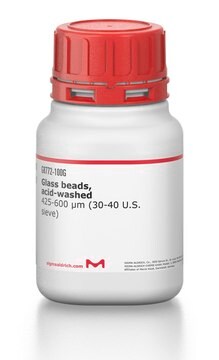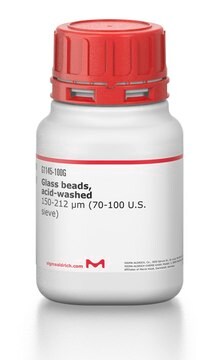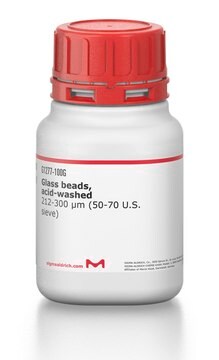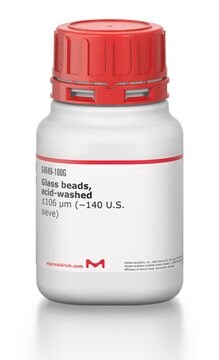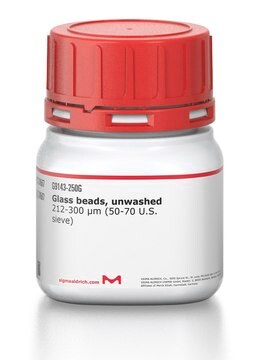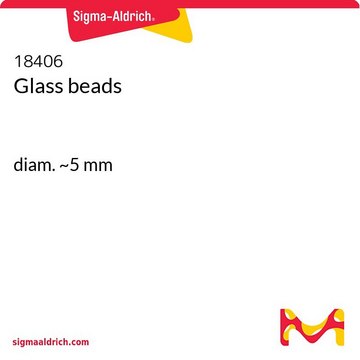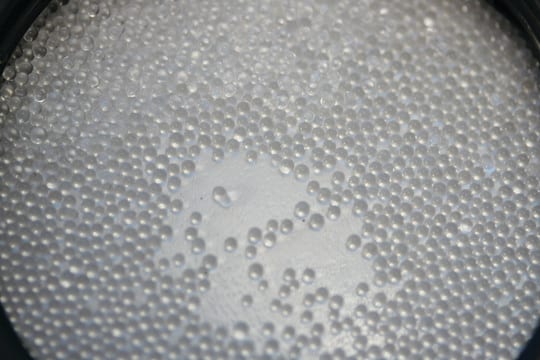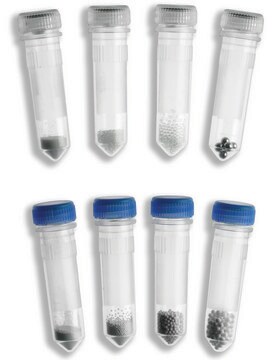G9268
Glass beads, unwashed
425-600 μm (30-40 U.S. sieve)
Sinonimo/i:
Glass beads
Autenticatiper visualizzare i prezzi riservati alla tua organizzazione & contrattuali
About This Item
Codice UNSPSC:
41100000
NACRES:
NB.22
Prodotti consigliati
Dimensione particelle
425-600 μm (30-40 U.S. sieve)
Applicazioni
Unwashedglass beads have been used:
- in the quantification of protein in fungal colonybiofilm
- in the lysis of microglial cells for the extraction andquantification of chlorophylls and cell mortality rate
- in the extraction ofDNA and RNA from microbial communities
Codice della classe di stoccaggio
11 - Combustible Solids
Classe di pericolosità dell'acqua (WGK)
WGK 3
Punto d’infiammabilità (°F)
Not applicable
Punto d’infiammabilità (°C)
Not applicable
Dispositivi di protezione individuale
Eyeshields, Gloves, type N95 (US)
Scegli una delle versioni più recenti:
Possiedi già questo prodotto?
I documenti relativi ai prodotti acquistati recentemente sono disponibili nell’Archivio dei documenti.
I clienti hanno visto anche
Xavier Garcia-Ortega et al.
Frontiers in bioengineering and biotechnology, 3, 107-107 (2015-08-19)
The most commonly used cell disruption procedures may present lack of reproducibility, which introduces significant errors in the quantification of intracellular components. In this work, an approach consisting in the definition of an overall key performance indicator (KPI) was implemented
Ruoyun Li et al.
Journal of proteomics, 203, 103377-103377 (2019-05-19)
The molecular mechanism of Saccharomyces cerevisiae tolerant to ethanol stress remains to be further elucidated. In this study, a comprehensive analysis based on RNA-seq and iTRAQ LC-MS/MS was used to investigate the global mechanism of S. cerevisiae strain Sc131 in
Daniel R Leadbeater et al.
Microbiome, 9(1), 48-48 (2021-02-19)
Salt marshes are major natural repositories of sequestered organic carbon with high burial rates of organic matter, produced by highly productive native flora. Accumulated carbon predominantly exists as lignocellulose which is metabolised by communities of functionally diverse microbes. However, the
Paola Gallardo et al.
Cell reports, 33(6), 108377-108377 (2020-11-12)
Upon acute heat stress (HS), overall mRNA transcription, processing, and export are inhibited, leading to cell growth arrest. However, how cells turn off mRNA metabolism is not fully understood. Here, we show that acute HS results in the segregation and
Humidah Alanazi et al.
BioMed research international, 2014, 963156-963156 (2014-10-11)
The predisposition of cigarette smokers for development of respiratory and oral bacterial infections is well documented. Cigarette smoke can also contribute to yeast infection. The aim of this study was to investigate the effect of cigarette smoke condensate (CSC) on
Il team dei nostri ricercatori vanta grande esperienza in tutte le aree della ricerca quali Life Science, scienza dei materiali, sintesi chimica, cromatografia, discipline analitiche, ecc..
Contatta l'Assistenza Tecnica.